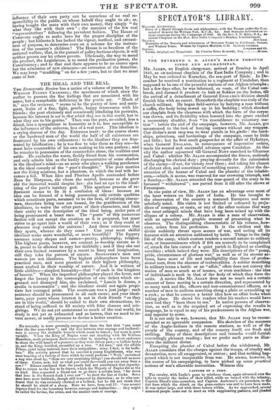No necessity is more generally recognized than the fact that
"one must draw the line somewhere"; and the hoe between true courage and foolhardi- ness is among the desirable bounds which must be traced ; but none is more variable. When the King of Naples %tent out shooting with Sir William Hamilton, mode principum Italicorum,—that is, standing in a stout enclosure to shoot the wild beasts of a preserve as they were driven past,—a buffalo broke in, and the King, terrified, scrambled up a tree. "All men," said the affable Prince, quiet being restored, have their antipathies ; mine, I find, is for buffa- loes." His activity proved that Le excelled a young Englishman, who was once boasting of a variety of feats which he could perform : exclaimed a wag who stood by, " these are very surprising things I you should tell us more of them. Come, now, tell us what you could do—could you run away from a cow ? " Silence confessed that the youth bad not ascertained that capacity. But to return to the line to be drawn, which the Majesty of Naples did at the ox kind. One requested a friend not to gn down a certain lane, "for down that lane is the fiercest duck I ever saw ": he drew the line at ducks. Some men have more fortitude, though still tempered by discretion ; as he who con- fessed that he was certainly alarmed at a bullock, but he did not think that he should be afraid of a sheep. Here we have, from real fife, three several degrees fixed for the boundary between courage and foolhardinet::: they might be called the bovine, the ovine, and the anatine tests of courage.


























 Previous page
Previous page